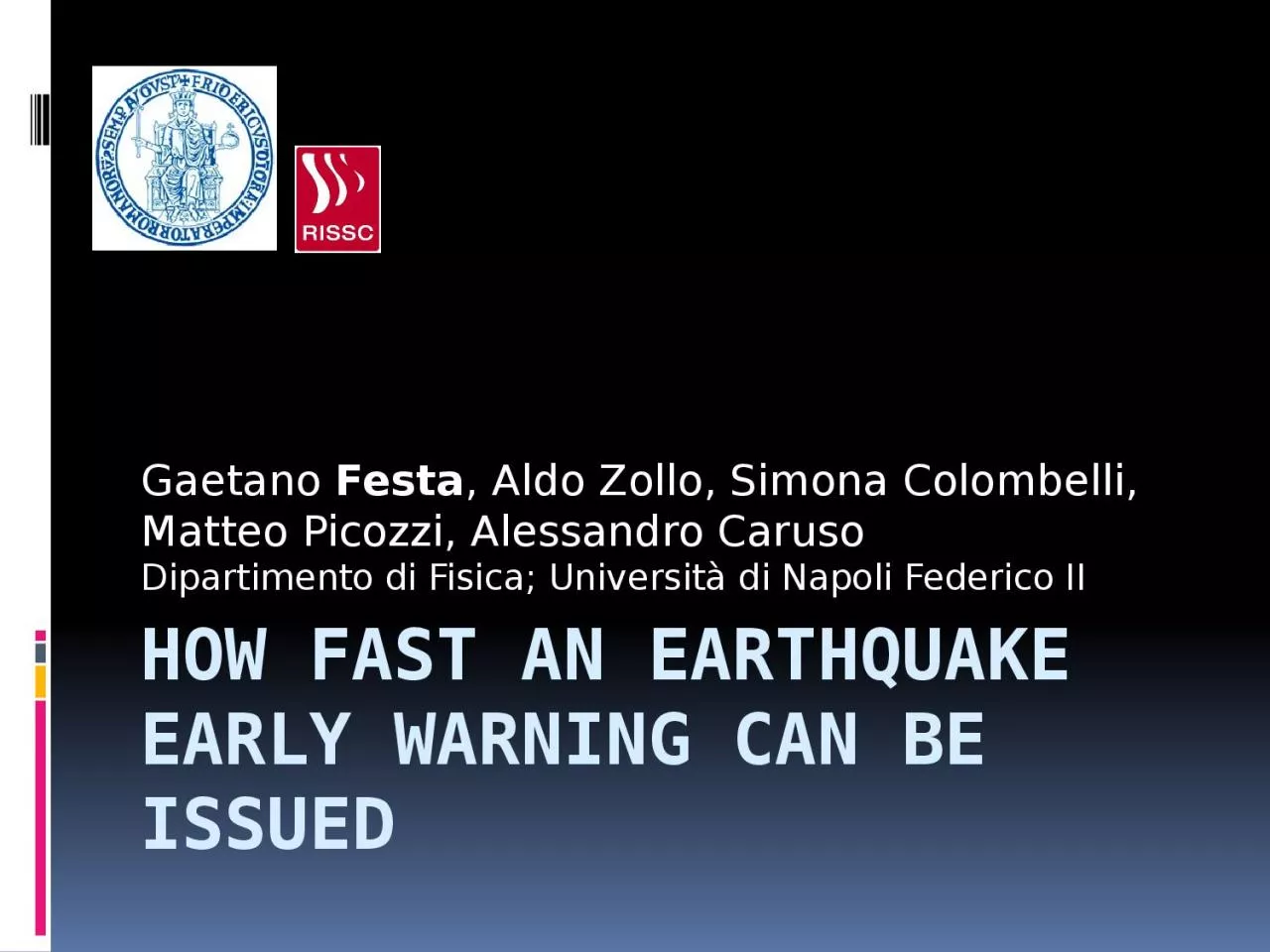

Early Warning can Be Issued Gaetano Festa Aldo Zollo Simona Colombelli Matteo Picozzi Alessandro Caruso Dipartimento di Fisica Università di Napoli Federico II Summary Earthquake ID: 1025083
Download Presentation The PPT/PDF document "HoW Fast an Earthquake" is the property of its rightful owner. Permission is granted to download and print the materials on this web site for personal, non-commercial use only, and to display it on your personal computer provided you do not modify the materials and that you retain all copyright notices contained in the materials. By downloading content from our website, you accept the terms of this agreement.
1. HoW Fast an Earthquake Early Warning can Be IssuedGaetano Festa, Aldo Zollo, Simona Colombelli, Matteo Picozzi, Alessandro CarusoDipartimento di Fisica; Università di Napoli Federico II
2. SummaryEarthquake Early Warning ConceptsMethodsSouthern Italy applicationNext generation of ew systems
3. decadesyearsdays Early WarningLong-TermForecastingShort-TermForecasting& PredictionLong-term Hazard MappingShakeMaps&Rapid Loss Assessment0minutesEarthquakesecondsdays/monthsAftershock HazardTime scales of seismic hazardFrom REAKT REAL-TIME SEISMOLOGY
4. Based on the difference between the propagation velocity of the seismic waves and radio signals or cableThe information about earthquake ground shaking can reach a target “potentially at risk” from a few to tens of seconds before the arrival of the largest amplitude seismic waves. EPICS-wave velocity: around 3.5 km/secFundamentals of EWTARGETLight speed: around 3x105 km/sec
5. 1715131197531024681012141618202224SECS AVAILABLE TO TARGETNAPLES85 kmCTARGETEarly Warning Time-Line – PRESTo PLUSSECS FROM ORIGIN TIMEOrigin TimeP-Waves at1st StationPOn-SiteAlertsProbabilisticLocationBayesianMagnitudeRegional ScalePeak Ground MotionPDZ - ProbableDamaged ZoneS-WavesAt Target
6. Worldwide EWS6
7. Regional vs Onsite EWEpicentral Area✹Warning (Light/connection Speed)Early Warning~ 10- 30 sPostevent~ 10 minTelemetryEvent detectionTPTStargetTimeT0P Waves (5-6 km/s)S/Surface Waves (3,3.5 km/s)RegionalOnsiteS/Surface Waves (3,3.5 km/s)targetLead-time(S-target)- (first-P network )(P-target)- (S target )
8. P-wave based Early WarningObjective: estimating fast and reliably the earthquake’s damage potential8
9. Lead-times for P-wave based EWSThe expected lead-time of Regional system increases with distance and is larger than for On-site systems for d>50 km.On-site systems can provide fast warning to targets close to the epicenter.9
10. In a dense network accurate location can be obtained within 3-4 s from OTEvents in the network outskirts require a longer time for the location to converge (6-10s) Real Time Earthquake Location (RTLOC)10Satriano et al., BSSA,2008
11. Magnitude: an empirical approach11Pd = peak displacementτc = average period log Pd = A + B * M + C log Rlog τc = A' + B' * MData from Japan,Taiwan, and ItalyData from European SM data-base
12. Real Time MagnitudeBasic ConceptsUse of information carried out by early P- and S-waves recorded at a dense, high dynamics network deployed in the source area of earthquakesDetermine empirical regression laws between real-time measured ground motion parameters (dominant period, peak displacement) and magnitudeAt each time step after first P, evaluate the magnitude using an evolutionary approach and combining P and S information at all recording stations
13. Offline application: The 1995 Kobe EqkProbability to exceed M 6.5 and M 7.0 thresholds as a function of timeM 6.5M 7.0Magnitude vs TimeLancieri & Zollo, JGR, 2008P(m|d) vs Time
14. Prediction of peak ground motion at the target siteUse of existing Ground Motion Prediction Equations (GMPE) for PGV,PGA, …At each time step, the instantaneous attenuation curve can be built given the estimated values of M.The map of predicted PGX is obtained by calculating the expected value of ground motion parameter, given the estimated Magnitude and Distance (from eqk location)Increasing MagnitudeLog( Epicentral distance)Log( Peak Motion amplitude)D1D2M1M2
15. T0PRESTo PLUS Playback of L’Aquila 2009, ML 5.9 EqkEpicenterVulnerable SiteS-WavesStationAlert LevelMagnitudeAccelerogramsP- and S-waves WindowsDepth
16. Issuing an EW alert: Can we by-pass the Magnitude estimation?Observed correlation between PD and PGV (Wu & Kanamori, 2005)For moderate to strong eqks PGV is related to seismic intensityUsing PD and Tau for setting up an alert decision tableFrom Kanamori, 2005
17. A Threshold-Based Early WarningInitial P-peak displacement (Pd) correlates with whole-record Peak Ground Velocity. Pd>0.2 cm PGV > 16 cm/sec IMM> VII : DAMAGING EQK!Initial P-period parameter (tc) correlates with final magnitude. tc > 0.6 sec M> 6JapanTaiwanCentral ItalyAlert levelsDamages nearby & far away from the stationDamages only nearby the stationDamages only far away from the stationNo damages3210Alert levels and threshold values for Pd and tcZollo et al., GJInt,2010
18. PGV IMMIJMAPDZColombelli et al., 2011, Test of a threshold-based Earthquake Early Warning method using Japanese data, Bull.Seism.Soc.Am.Test of the Threshold Method on Japanese EqksQualitative comparison of theThreshold Early Warning methodwith IMM maps ofthree Mw>6 earthquakes in Japan occurred during the last decade
19. Southern Italy –ISNet & INFO
20.
21. Toward next EWS generation21Real time GPS applicationLow-cost sensorsNEW EWSDifferent initial Pd slopeEarly Warning for Mega-Earthquakes
22. Future challengesRobustnessTimeActualFutureBlind zonePastFutureReal time continuous data processingA-prioriBayesian combinationHPCEvolutionary Ground shaking
23.